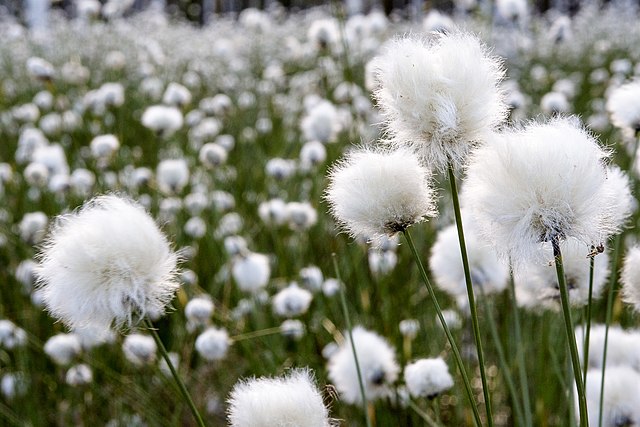 |  |  |  |  |
 |  |
The hare’s-tail Cottongrass is a perennial herb of the sedge family, 30-90 cm tall. It forms dense sods and tussocks. The leaves are green, numerous, narrow - up to 1 mm wide, rhizomes, three-fold, flat or linear-ylinoid, three-sided with a closed sheath. Stem leaves with undeveloped plate and inflated sheath. Inflorescences are head-shaped, consisting of a single spike at the top, which is 3-4 cm in diameter. Flowers inexpressive, small, bisexual. Inflorescence reduced to filiform hairs, which grow strongly during fruiting and form white fluff.
The fruit is nut-like. Blooms in April-May, overwinters green.
The above-ground part of the plant is used for medicinal purposes. Collect the plant at the moment when the white hairs start to form and dry as usual, in a shady and well-ventilated place or in forced dryers, not exceeding 35C. When harvesting the herb, the fluffy heads are collected separately from the leaves. The drug can be stored for no longer than 2 years.
There are not many studies on this plant and it can be said that it has been studied insufficiently. Silicic acid has been found in the sheath of leaves and stems. An essential oil is found in the roots. In addition, the plant has a high content of proteins, sugars, vitamins and trace elements.
Medicinal significance
The plant is not used in official medicine, but it has properties that are also known to the official. The hare’s-tail Cottongrass has anti-inflammatory, diuretic, pain-relieving, antipyretic and sedative properties. Beneficially affects the digestive tract. The hare’s-tail Cottongrass perfectly flushes uric acid salts from the body.
In folk medicine, the hare’s-tail Cottongrass is used much more widely, it is used as an anti-inflammatory and diuretic agent. Plant extracts with the fruits of this plant are used as a pain reliever, antipyretic and sedative.
The plant is widely used to prevent disorders and inflammations of the digestive tract, as well as to reduce pain in intestinal tenesmus, arthritis and rheumatism.
Medicinal and fruit decoction is used as a sedative to prevent various nervous problems, epilepsy and other disorders of the nervous system. Decoctions are also excellent in the treatment of various infections, diarrhea and intestinal inflammation.
Evaporation of the plant* is used long-term in case of gout and joint pain, as it helps to flush out uric acid salts from arsenic. This steaming can also be used for external use - making compresses directly on the painful area.
*steaming - it is usually prepared in rural conditions, when finely cut drogo is poured with hot water and heated in a wood-burning oven throughout the night. This can be repeated using a not very good quality thermos that does not retain heat very well.
